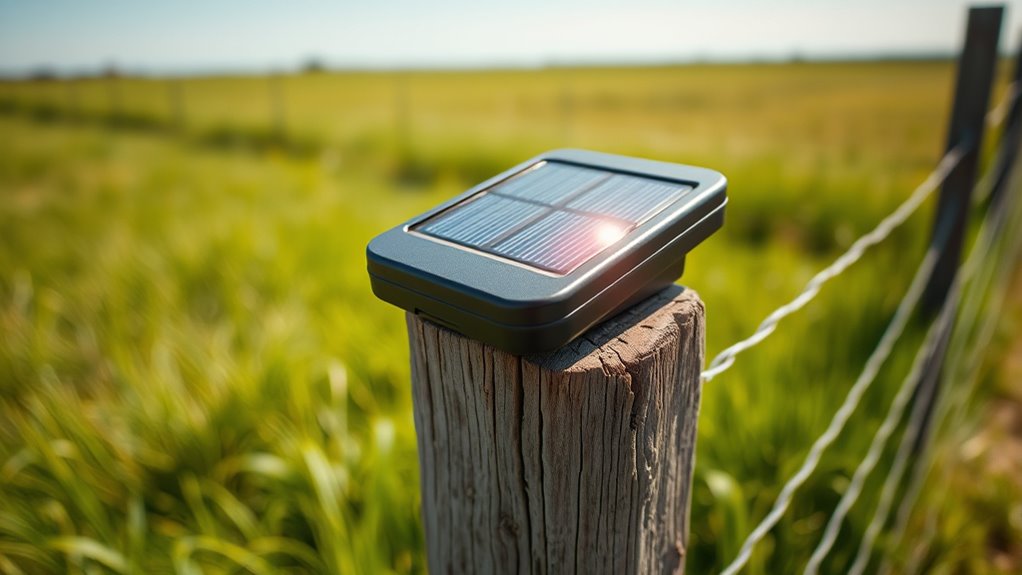During summer, your solar-powered fence charger can perform well if you optimize for high temperatures and extended daylight. Heat can reduce panel efficiency and strain batteries, but proper placement, shading, and using heat-resistant materials help sustain performance. Regular cleaning and maintenance prevent overheating and ensure continuous charge. Long daylight hours boost energy collection, but monitoring for dust, humidity, and environmental stress is key. Keep exploring to find tips that keep your system reliable all season.
Key Takeaways
- Proper placement and regular cleaning optimize solar panel efficiency during hot summer months.
- Heat-resistant components and thermal management extend fence charger lifespan in high temperatures.
- Using high-quality, temperature-tolerant batteries ensures reliable power throughout extended summer periods.
- Adequate ventilation and shading prevent overheating, maintaining consistent fence security performance.
- Longer daylight hours enhance solar energy collection, reducing maintenance and maximizing system uptime in summer.
Assessing Solar Charger Efficiency in High Temperatures

High temperatures can considerably impact the performance of solar fence chargers, making it essential to assess their efficiency under such conditions. When evaluating your system, focus on how the solar panel mounting influences heat absorption and airflow. Proper mounting guarantees ideal sunlight exposure while minimizing heat buildup, which can reduce energy conversion efficiency. Elevated temperatures can also shorten your battery lifespan, so check if your charger has cooling features or heat-resistant components. Regularly inspecting your setup for signs of overheating or panel discoloration helps maintain peak performance. Additionally, understanding solar panel efficiency can help you optimize your system’s placement and operation during hot summer days. Ensuring proper ventilation around your solar panels and choosing the right mounting position can substantially improve efficiency during hot summer days, protecting your investment and keeping your fence energized. Proper heat dissipation strategies are also crucial for preventing thermal overload and maintaining consistent energy output. Moreover, selecting high-quality components can further enhance the durability and performance of your solar-powered system in extreme temperatures. Taking into account thermal management techniques, such as using reflective coatings or heat sinks, can also contribute to better system resilience in high temperatures.
Battery Performance and Durability During Summer Months
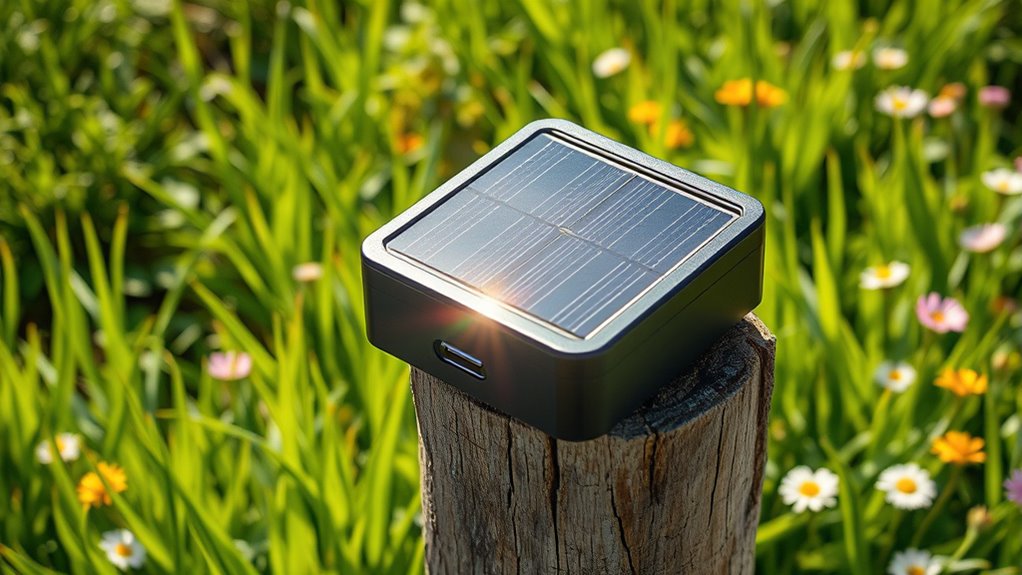
During summer, your fence charger’s battery needs to hold its charge well despite the heat. You’ll also want the solar panel to stay efficient in strong sunlight, ensuring consistent power. Additionally, the battery’s durability in high temperatures directly impacts the charger’s reliability over time. Incorporating dynamic communication exercises can help you understand and troubleshoot any performance issues more effectively. Regular monitoring of battery performance and temperature resilience can further improve the system’s solar panel efficiency during peak summer conditions.
Battery Charge Retention
When summer heat intensifies, battery charge retention becomes essential for maintaining your solar-powered fence charger’s reliability. High temperatures can accelerate battery drain and reduce overall battery longevity. To optimize performance during hot months, consider these key factors: 1. Guarantee your battery supports many charge cycles, so it maintains capacity over time. 2. Avoid deep discharges that can shorten battery life. 3. Regularly check for signs of overheating and give batteries adequate cooling if needed. 4. Selecting batteries with proven charge cycle durability can help ensure consistent performance during extended periods of intense heat. Ensuring your battery has good thermal management can also prevent overheating and prolong its lifespan during hot weather. Additionally, choosing batteries with high-temperature tolerance can further enhance the durability and efficiency of your solar-powered fence charger in summer conditions. Incorporating batteries with robust chemistry can also improve overall resilience against temperature fluctuations, ensuring reliable operation throughout the season. Moreover, selecting batteries with advanced electrolyte composition may provide extra protection against temperature-induced capacity loss, further improving summer performance.
Solar Panel Efficiency
Have you noticed how solar panel performance can decline in the scorching summer months? High temperatures can reduce efficiency, so proper solar panel placement is essential. Position your panels where they receive direct sunlight for most of the day, avoiding shaded areas caused by trees, buildings, or fences. Shading considerations are critical because even partial shade can considerably decrease energy output. Ensure that panels are mounted at the correct angle to maximize sun exposure during peak hours. Keep panels clean and free of dust or debris, which can block sunlight and reduce efficiency. Regularly inspecting your setup helps catch any shading issues early. Additionally, understanding solar panel cooling can help you implement strategies to mitigate heat effects and maintain optimal performance. Proper solar panel maintenance can further enhance efficiency and longevity. Being aware of credit card security measures can prevent potential breaches and protect your investment. By optimizing placement and considering shading, you’ll guarantee your solar-powered fence charger works reliably throughout the summer, maintaining ideal battery performance.
Durability in Heat
Solar panels may perform well with proper placement, but the batteries powering your fence charger also face challenges in hot weather. Heat can accelerate solar panel degradation and impact battery life. To guarantee durability during summer months, consider these factors:
- Use batteries made from heat resistant materials to withstand high temperatures without losing capacity.
- Opt for chargers with built-in cooling features to prevent overheating and prolong battery lifespan.
- Regularly inspect and maintain your system to identify early signs of battery wear caused by heat stress.
- Ensuring proper ventilation and airflow around the batteries can help mitigate heat buildup and extend their operational life. Additionally, selecting batteries with thermal management systems can further enhance durability in hot conditions.
- Proper installation and placement of batteries away from direct sunlight can significantly improve their longevity during summer heat.
- Choosing batteries with robust construction can also help them resist damage from temperature fluctuations and prolong their effective service life. Incorporating temperature sensors can provide real-time monitoring and help prevent overheating issues.
Impact of Long Daylight Hours on Charging Capacity
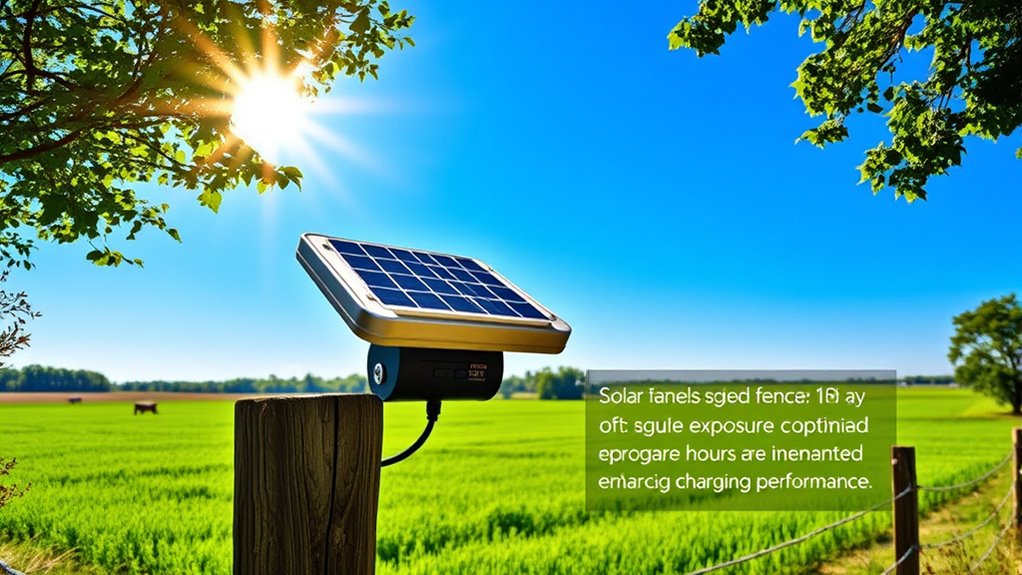
Long daylight hours mean your solar fence charger receives more sunlight, boosting its charging capacity. This increased exposure leads to more efficient energy collection and longer periods of operation. As a result, your system stays powered longer without needing additional maintenance. Proper placement of your solar panels is essential to maximize sunlight absorption and ensure optimal performance. Additionally, understanding the performance benefits of tuning your system can help you achieve better energy efficiency and durability.
Increased Sunlight Exposure
When daylight hours increase during the summer months, your fence charger benefits from more prolonged exposure to sunlight. This increased exposure boosts the solar panel’s ability to generate power, enhancing overall performance. Key benefits include:
- Extended Charging Time: Longer days mean your solar panel can collect energy for more hours, ensuring your fence remains charged throughout the day.
- Higher Sunlight Intensity: Stronger sunlight improves the efficiency of energy conversion, giving your charger a reliable power source.
- Improved Solar Panel Longevity: Consistent sunlight exposure helps maintain the health of your solar panel, preventing degradation and ensuring long-term durability.
Enhanced Charging Efficiency
As daylight hours increase, your fence charger’s charging capacity naturally improves because the extended exposure to sunlight allows the solar panel to collect more energy throughout the day. The effectiveness of this process depends heavily on the solar panel materials, which determine how efficiently sunlight is converted into electrical energy. Modern panels made from high-quality silicon or advanced thin-film materials maximize energy absorption. Additionally, the battery chemistry inside your charger plays a vital role in storing this energy. Lithium-ion batteries, for example, offer better charge retention and faster charging cycles compared to older chemistries. As a result, longer daylight hours enhance charging efficiency by providing more consistent energy input, ensuring your fence charger remains fully powered and ready to perform whenever needed.
Longer Operational Hours
Extended daylight hours directly boost your fence charger’s operational time by providing more consistent energy input. With longer summer days, your solar panel installation captures more sunlight, increasing energy production. This extra energy helps keep your fence charger running longer without interruption. To maximize benefits:
- Ensure ideal solar panel placement for maximum sunlight exposure.
- Regularly clean your solar panels to maintain efficiency.
- Recognize that increased charging during extended daylight can extend your battery lifespan, delaying replacements and saving money.
Longer daylight hours mean your fence charger has more time to recharge, reducing downtime and improving fence security. By leveraging the natural summer sunlight, you get consistent power, fewer battery issues, and peace of mind knowing your system operates efficiently all day long.
Ensuring Consistent Power Supply in Hot Weather
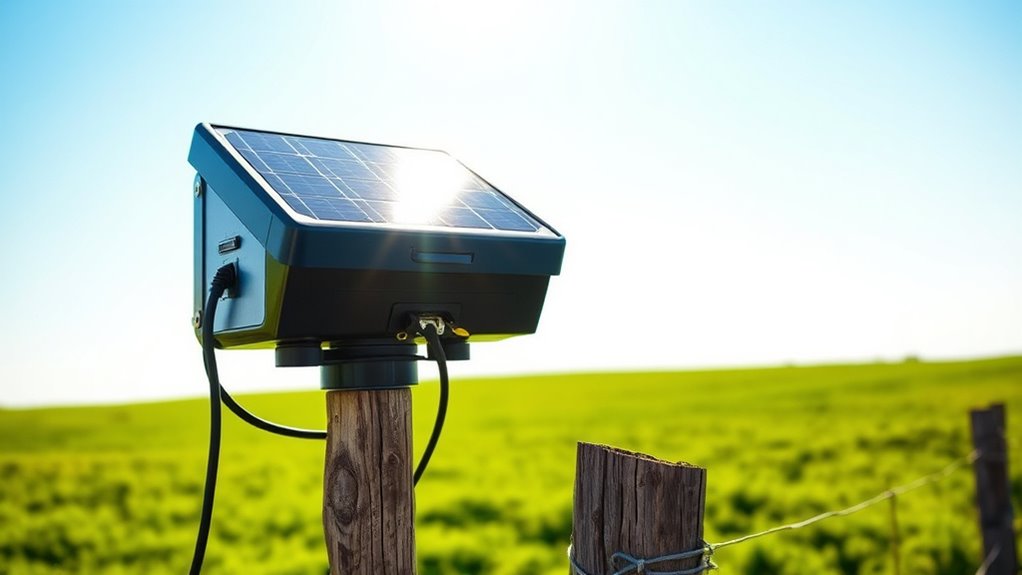
Hot weather can considerably reduce the efficiency of solar-powered fence chargers, making it essential to take proactive steps to guarantee a consistent power supply. To combat this, consider using fencing materials that reflect sunlight rather than absorb heat, helping keep panels cooler. Installing bird deterrents around the solar panel can prevent birds from nesting or perching, which can block sunlight and reduce energy intake. Regularly cleaning the panels removes dust, dirt, and debris that accumulate faster in hot, dry conditions, maintaining ideal performance. Positioning panels in shaded areas during peak heat hours can also help protect them from excessive sunlight exposure. By managing these factors, you maintain steady power, ensuring your fence charger functions reliably even during hot weather.
Comparing Solar Panel Technologies for Summer Use
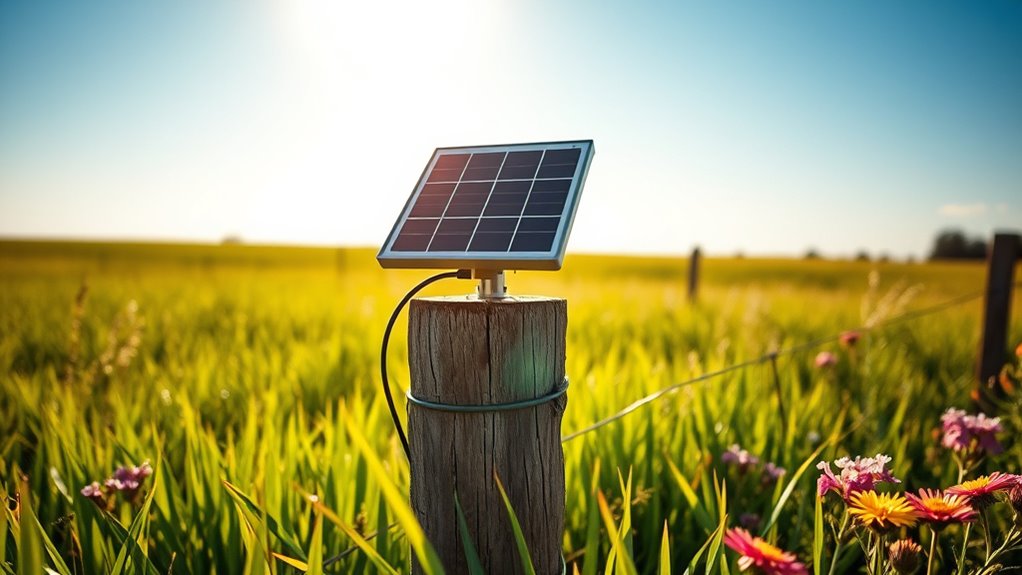
Choosing the right solar panel technology is crucial for maximizing fence charger performance during summer months. Different solar panel materials, such as monocrystalline, polycrystalline, and thin-film, offer varying efficiencies. To help you decide, consider these factors:
Selecting the best solar panel material enhances fence charger efficiency in summer.
- Efficiency and Power Output: Monocrystalline panels typically deliver the highest efficiency, making them ideal for limited space.
- Shading Effects: Polycrystalline panels are slightly more tolerant to shading, which can be common during summer with overgrown vegetation.
- Durability and Cost: Thin-film panels are less efficient but often cheaper and more flexible, suitable for rugged environments.
Resistance to Environmental Factors: Heat, Dust, and Humidity

When selecting a solar-powered fence charger, it’s important to evaluate how well the panels can withstand environmental challenges like heat, dust, and humidity. Look for models with good shade coverage, as prolonged exposure to direct sunlight can cause overheating, reducing efficiency. Dust accumulation can impair panel performance, so choose chargers with dust-resistant designs or easy cleaning features. Humidity and moisture can lead to corrosion, so ensure the charger has proper sealing and corrosion-resistant materials. Wind resistance is also essential; sturdy mounts and durable casing help prevent damage during storms or high winds. A charger that can endure these environmental factors maintains consistent performance, guaranteeing your fence remains effective throughout the summer without frequent replacements or repairs.
Maintenance Tips for Optimal Summer Performance

Regular maintenance of your solar-powered fence charger guarantees it performs at its best during summer months. To make certain of peak performance, focus on key fence charger maintenance tasks.
Regular fence charger upkeep ensures peak summer performance and reliability.
- Check the solar panel installation regularly to make sure it’s clean and receives maximum sunlight. Wipe off dust, dirt, or debris that can block sunlight and reduce efficiency.
- Inspect the fence line for breaks, loose wires, or vegetation contact that might hinder the shock delivery.
- Test the charger’s output periodically to confirm it’s delivering adequate pulses. If performance dips, consider repositioning or upgrading your solar panel for better sunlight exposure.
Following these maintenance tips helps your solar charger stay efficient and reliable throughout summer, maximizing its power and effectiveness.
Cost-Effectiveness of Solar Chargers in Peak Season

During peak season, solar-powered fence chargers often prove highly cost-effective because they eliminate the need for costly electricity or battery replacements. You’ll notice significant cost savings since sunlight fuels the charger, reducing energy bills. Plus, the installation process is straightforward, often requiring minimal tools and effort, which cuts down on setup costs and time. Because they rely on free solar energy, you won’t worry about fluctuating energy prices or frequent maintenance expenses. This ease of installation means you can quickly set up or reposition the charger as needed, maximizing efficiency during the busy summer months. Overall, solar chargers deliver a strong return on investment by lowering ongoing expenses while offering reliable performance in peak season.
User Experiences and Practical Insights During Summer
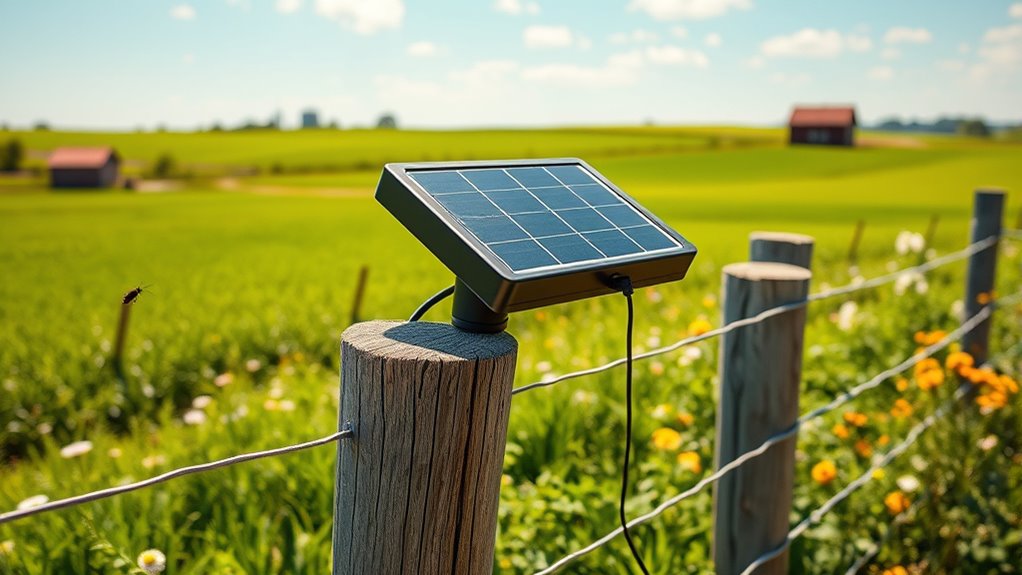
Many users find that solar-powered fence chargers perform exceptionally well in summer, providing reliable power even on the hottest days. They often share practical insights that can help you maximize performance:
- Proper solar panel installation is key—position panels where they get direct sunlight for ideal charging.
- Ensuring correct fence charger wiring prevents power loss and boosts efficiency.
- Regularly cleaning solar panels helps maintain maximum energy absorption during long sunny periods.
These tips let you enjoy uninterrupted fence security without worrying about power dips. Users also report that lightweight, weather-resistant designs handle summer storms well, making solar chargers a dependable choice. With proper setup and maintenance, your solar-powered fence charger can keep your property secure all season long.
Frequently Asked Questions
How Do Solar Fence Chargers Perform in Extremely Hot and Humid Climates?
In extremely hot and humid climates, solar fence chargers may face challenges like solar panel degradation, which can diminish efficiency over time. However, if you choose models with a heat resistant design, they can perform reliably despite the harsh conditions. Regularly check your charger to guarantee it’s functioning well, and opt for units built specifically for high temperatures to maximize their durability and performance during summer.
What Are the Best Practices for Maintaining Solar Panels in Summer?
To keep your solar panels performing well in summer, you should regularly perform solar panel cleaning to remove dust and debris that can block sunlight. Additionally, practice shade management by trimming nearby trees or adjusting panel angles to minimize shading. These steps guarantee maximum sun exposure, improve efficiency, and extend your solar charger’s lifespan during hot months. Regular maintenance helps you get the most out of your solar-powered fence charger.
How Does Seasonal Variation Affect Solar Charger Output and Efficiency?
Think of your solar charger as a sun-kissed garden—its energy blooms with sunlight, but seasonal shifts can cast shadows. Seasonal variation affects output by reducing sunlight hours and intensity, which impacts efficiency. Shading impact becomes more pronounced as trees grow or leaves fall, causing solar panel degradation over time. To keep your system thriving, monitor seasonal changes and minimize shading, ensuring your solar charger captures maximum sunlight year-round.
Are There Any Safety Concerns With Solar Fence Chargers During Heatwaves?
During heatwaves, safety concerns with solar fence chargers include fire risk and panel overheating. You should guarantee your charger is installed in a shaded, well-ventilated area to prevent overheating. Regularly check for signs of damage or excessive heat, and make sure the system is properly maintained. Taking these precautions helps reduce fire hazards and ensures your solar charger operates safely during extreme heat conditions.
What Features Should I Look for in a Solar Charger for Summer Durability?
Ever wondered what makes a solar charger summer-proof? Look for durability features like sturdy, weather-resistant casings that withstand intense sun, rain, and heat. Check if it offers UV protection and sealed components to prevent water damage. Is the solar panel highly efficient and resilient? These features ensure your charger stays reliable during summer, so you can keep your fence energized without worry. Prioritize weather resistance and durable build quality to get the best summer performance.
Conclusion
As summer tests your solar fence charger’s limits, remember that with the right setup, it’s like having an unstoppable energy fortress. By choosing the best technology, keeping it maintained, and understanding seasonal challenges, you’ll guarantee your fence stays powered through the hottest days. Think of your solar charger as a superhero—resilient, reliable, and ready to conquer even the most intense summer heat. Stay vigilant, and your fence will stand tall all season long!

